Rose bath bombs are a great way to enjoy the luxury of bath bombs, without the fragrances of commercial products. Using natural oils, colours, and salts, this bath bomb is designed to be relaxing, and natural, for your bath enjoyment.
DIY Relaxing Rose Bath Bombs that are exquisitely giftable.
Bath bombs are a fizzy parcel of hydrotherapy in a joyful single-serving portion. The dry spherical bomb enters the bathtub and immediately erupts in fizzy, foaming delight that is reminiscent of the volcano demonstrations at grade one science fairs. However, the bath bomb is even more wonderful because it explodes with fragrance and herbal goodness, moving a mundane bath into the realm of therapeutic delight that is one of the benefits of bath bombs. But even though they are wonderful, soothing, and fragrant, the technique necessary to make them at home is difficult to master.
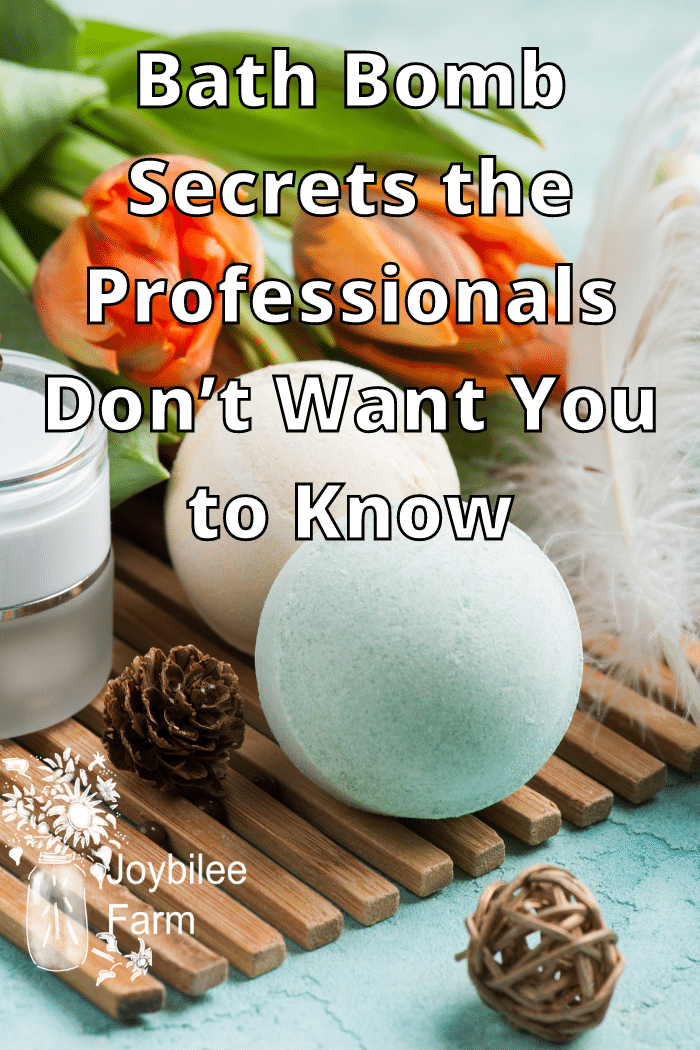
I thought bath bombs would be my defeat. For a few years now I’ve tried to make these for gifts. I’ve had eternally fizzing messes rather than giftable bombs. I’ve tried changing the recipe, using witch hazel instead of water, Dead Sea Salt instead of Epsom salts, and even omitting the essential oils. But nothing really stopped my bombs from fizzling out prematurely. Now the good news is that bombed bath fizzies, once dry, can be broken up and put in a jar for a bubble bath. But they just aren’t as fun to give as gifts.
Bath salts aren’t too expensive in the store. But fizzy bath bombs are Lush-worthy at $7 apiece, in Canada. That’s an impressive gift, don’t you think?
This recipe was a collaborative effort. As I was close to giving up in defeat, I asked for a little help from my tribe. Amanda from The Orange Blossom Soap Company in Amarillo, Texas, analyzed my recipe for me and gave me her expert advice so that my next bath fizzy wouldn’t bomb. (pun intended) Thank you, Amanda. The ladies on my gift list thank you.
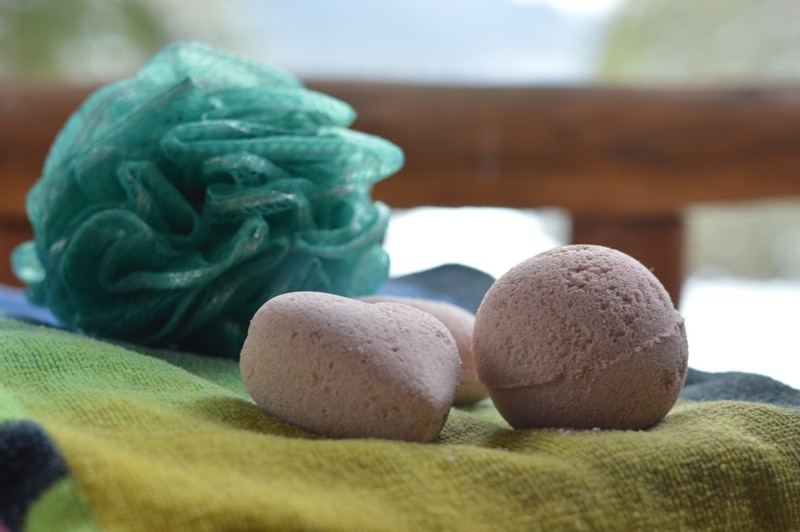
Here’s how to make your bath bombs successful
Choose a day to make bath bombs when the humidity is under 40%. If you have a high humidity day, with a chance of showers, the salt in the bath bombs may absorb moisture out of the air and fizz up prematurely. It’s not a good day to make these if it’s raining.
This bath bomb gets its pink shade from rosehip extract, which is a water-soluble colouring, rich in vitamin C as well as 32 other vitamins and minerals. Rosehip extract is astringent, anti-inflammatory, and helps with joint and muscle pain. It improves the elasticity of the skin, as well. Doesn’t that sound perfect for YOUR luxurious bathtime?

The colour is pale until you start spritzing it with alcohol. But when it hits the bathtub, you’ll see a nice pink fizz, while it adds all of its rosy nourishment to the bath, without the use of dyes.
The essential oils in this recipe were picked for their relaxing, anti-inflammatory qualities. Cedarwood Atlas essential oil is known to reduce cellulite and increase feelings of relaxation and well-being, while rose geranium and lavender are both anti-inflammatory and analgesic, with mood-lifting qualities. The predominant scent is rose. If you prefer other essential oils, you can tweak the recipe to your scent preferences. This is one of the beauties of homemade bath bombs.
Relaxing Rose Bath Bombs
Yield: 6 large bath bombs
Ingredients:
-
- 1 cup of baking soda (sodium bicarbonate)
- ¼ cup Celtic sea salt, fine grade
- ¼ cup kaolin clay
- 1 tbsp. rosehip extract/colorant (optional)
- 1 tbsp. rosehip seed oil
- 2 tsp. sunflower lecithin
- 10 drops cedarwood atlas essential oil
- 12 drops lavender essential oil
- 10 drops rose geranium essential oil
- ½ cup citric acid, non-GMO
- 4 to 8 spritzes of Isopropyl alcohol
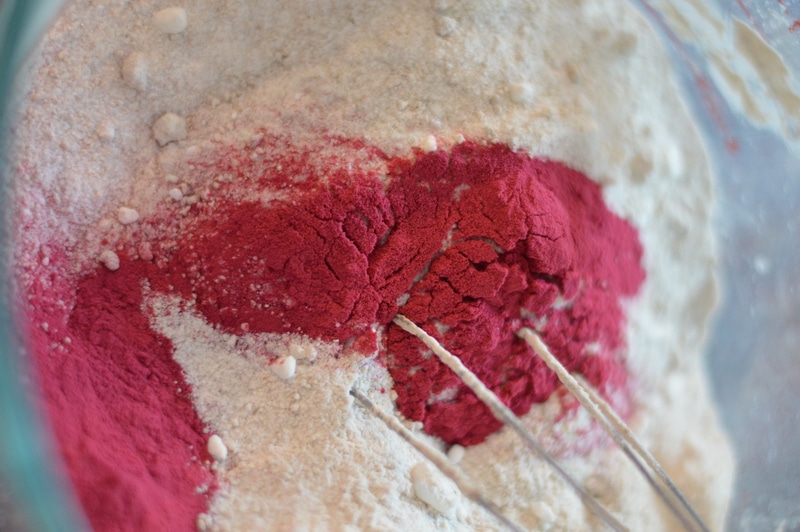
Equipment needed:
- Wire Whisk
- Glass mixing bowl
- Spray bottle for isopropyl alcohol
- Bath bomb molds like this or this
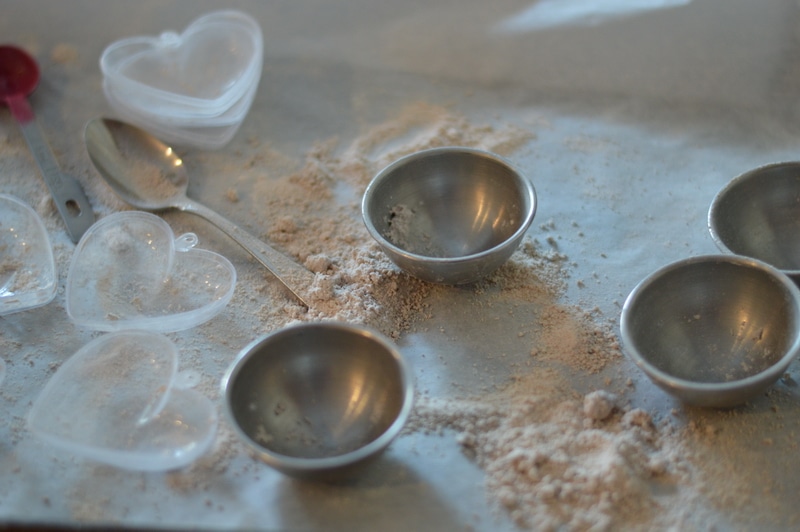
Directions:
- Place baking soda, sea salt, clay, rosehip extract/colourant, rosehip seed oil, and lecithin into the mixing bowl. Whisk the mixture to blend in the colour and remove any clumps of baking soda. Whisk until it is of uniform fine consistency and pale pink in colour.
- Using the whisk, stir in the essential oils. Mix well so that the mixture has a uniform consistency.
- Whisk the citric acid into the mixture. There is no water in this mixture so there should be no foaming up. Mix fully with the whisk.
- There is no need to treat the molds. The mixture will drop out of the molds without issue.
- Working in a well-ventilated area, spritz the mixture lightly with the alcohol, while whisking to prevent a fizzing reaction. Avoid breathing in alcohol. Add only enough alcohol to allow the mixture to clump together when squeezed in your hand. It should have the moisture content of barely damp sand. Try three spritzes and then check the consistency. Test it to see if it will hold together. It should be fluffy after spritzing, not dense and wet.
- Only add more alcohol if the mixture won’t hold together easily. How much alcohol you need depends on the relative humidity in your air.
- Using the bath bomb mold, scoop up enough of the mixture into each half of the bath bomb, so that both sides are over-full. Really pack it in. Press the two halves of the mold together tightly, to compress the mixture into a tight package. Brush off any excess mixture.
- Allow the mold to sit undisturbed for 10 to 15 minutes. Tap the outside of the mold on both sides with the back of a spoon to loosen the bath bomb. Open the mold and pop out the bath bomb onto a piece of parchment paper-lined baking sheet. Be gentle. The bath bomb will solidify as it dries.
- Allow the bath bombs to dry overnight. Turn it over and dry for an additional 12 hours. Wrap the bath bombs in plastic wrap or shrink wrap, if desired, to make them more secure if you are gifting them.
To Use Bath Bombs:
Drop one bath bomb into a bath of hot water, just before you are ready to enter the bath. The lecithin allows the oil in the bath bomb to mix with the water so that your tub doesn’t become slick with the oil.
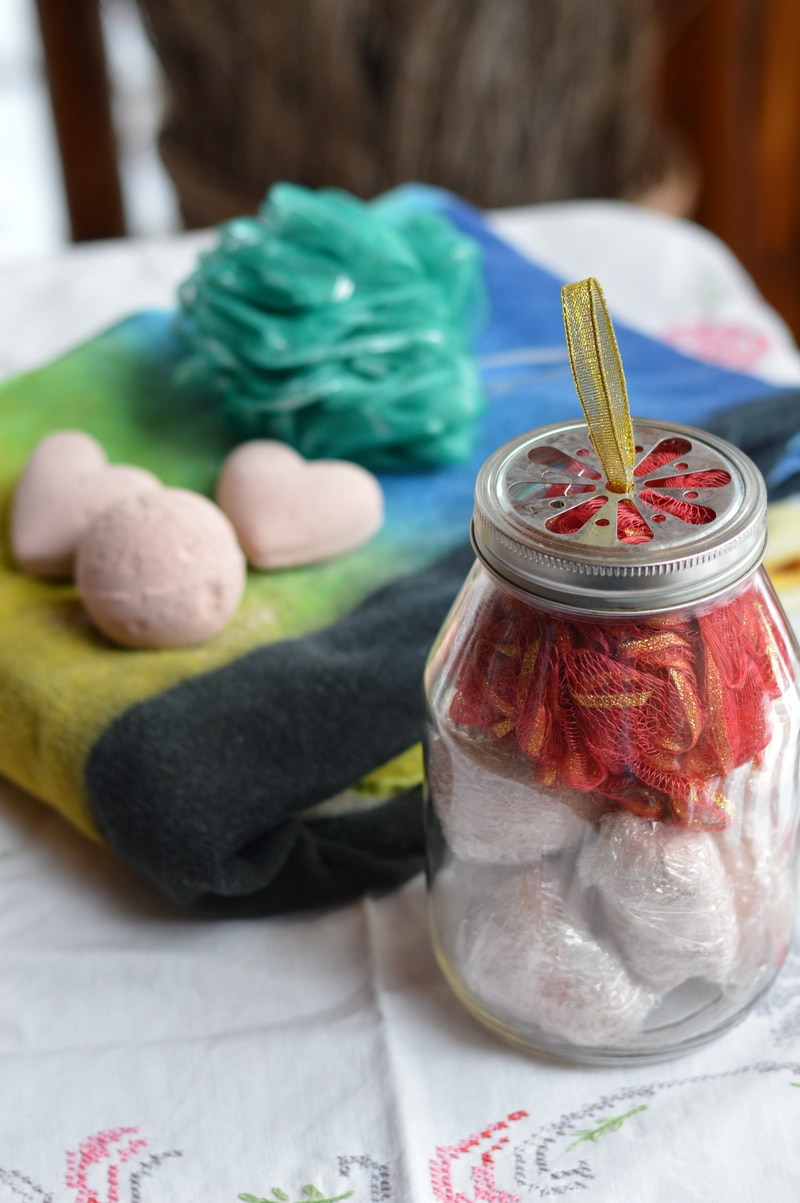
6 Bath bomb secrets so you can invent your own
- Don’t use Epsom salts or the Dead Sea salts. Save these for bath salts, or salt scrub. The magnesium draws moisture from the air and encourages premature fizzing.
- Go easy on the percentage of oils in the recipe. Too high a percentage of oils can cause the bath bombs to remain soft, instead of hardening.
- Use 90% or higher isopropyl alcohol as the liquid. Water, witch hazel, and other common liquids used for bath bombs are fine in a desert climate, but if you live where there is any humidity they will cause premature fizzing. Isopropyl alcohol evaporates quickly so you can avoid the worst of the fizz.
- Begin the recipe with 2 parts baking soda to 1 part citric acid and 1/2 part modulator like rice flour, salt, or clay. The modulator inhibits the reaction between the acid and the baking soda, giving you more time to mix in the liquid.
- Avoid liquid food colourings until you are comfortable with the method. Water-soluble colour can be added to the alcohol in the spritz bottle.
- One cautionary tale. Do avert your face from the isopropyl alcohol fumes, as you are working. I didn’t the first time and had a painful day or two till my lungs worked out the inflammation.
Wrapping up bath bombs for gifts
I recommend wrapping bath bombs in plastic wrap and then in pretty packaging. If you have some pretty gauze drawstring bags, they would be perfect for displaying the bath bombs. And they could be reused over and over again. I gifted these in a recycled 1 ½ quart glass mayonnaise jar with a wide mouth lid. I tucked a bath pouf in the top and put on a daisy lid to allow the ribbon from the bath scrubby to pull through. This lets the sweet rose fragrance out of the top of the jar.
The 1 ½ quart jar held 6 fizzy bombs, but a one-quart wide-mouth jar held only 3.
Enjoy!
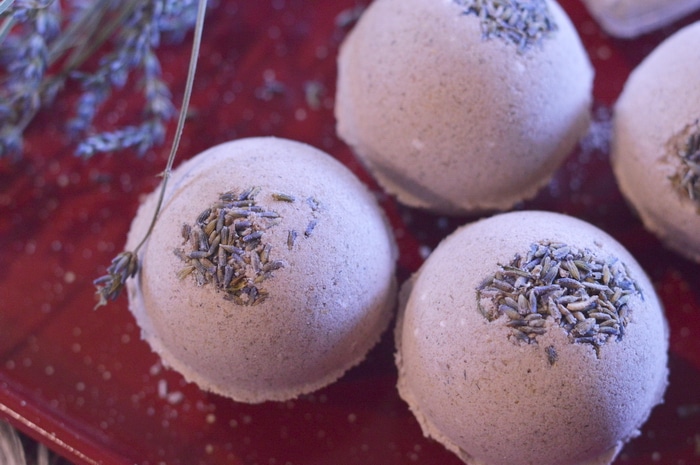
More Bath Bomb Recipes
Dandelion Bath Bombs This is a great bath bomb recipe for muscle soreness and to help relax muscles after hard workouts or a long day of work. It’s also a bright and uplifting combination.
Colloidal Oatmeal and Lavender Bath Bombs is a great option for self-care, and is a simple diy bath bomb recipe. This specific recipe has kid-safe ingredients, and is a great option for gift baskets.
Luxuriate and relax with DIY Bath Bombs, and make your own luxurious bath. You can add other oils to bath bombs, besides the essential oils for scent, but keep the ratio low. Some people will add a small amount of coconut oil, or sweet almond oil to make their own luxury bath bombs.
If you want a genuinely luxurious bath, this Gold, Frankincense, and Myrrh one is great for Christmas, self-care, or gifting.
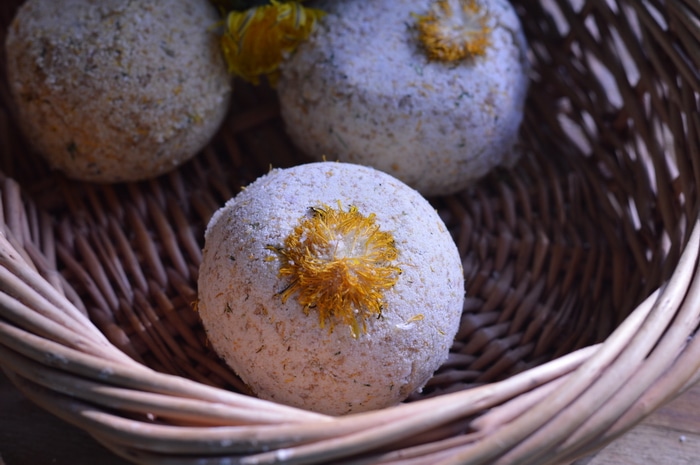
More herbal bath goodness
Make Herbal Bath Salts with Dead Sea salts, and you can add scents to these salts if you so wish. Chose your own favourite essential oils, and enjoy bath time all the more. You can also try making herbal bath teas, using herbs you are growing in your garden, learn how to do it by Creating Herbal Healing Baths from Your Garden. A simple start for an herbal bath salt variation is this Fir Needle Detox Bath Salts, the fir needles can be harvested or wildcrafted year-round. When you want to create your own variations learn how to Create a Custom Bath Salts Blend with this Master Recipe and enjoy personalized bath salts as much as you want.





Polysorbate 80 is toxic. Yes, it is still widely used, much like fluoride. Which is also toxic.
A good alternative to polysorbate 80 is liquid castile soap. Another good alternative is turkey red castor oil. Both work very well.
Add just a little bit of liquid castile soap (or turkey red castor oil) to your bath bomb mix. Whisk it in really well before using your alcohol spritz. This will make it easier to clean your bath tub after using your charcoal bath bomb. Liquid castile soap is completely non-toxic. Dr Bronners is a decent brand.
Add citric acid with the dry ingredients.
Please clarify: add citric acid AFTER wet and dry is mixed together? Or just the last ingedient BEFORE mixing?? Thanks so much
Thank you so much for explaining the humidity factor and how to solve it. I have been trying to make toilet bombs and the mixture always expands and I couldn’t figure out why. Very few mention the humidity as being a factor.